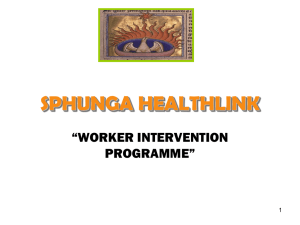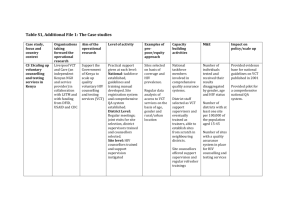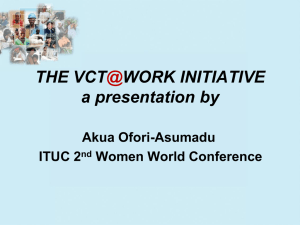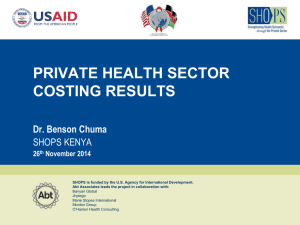introduction of user free services ... barriers created by other factors ...
advertisement
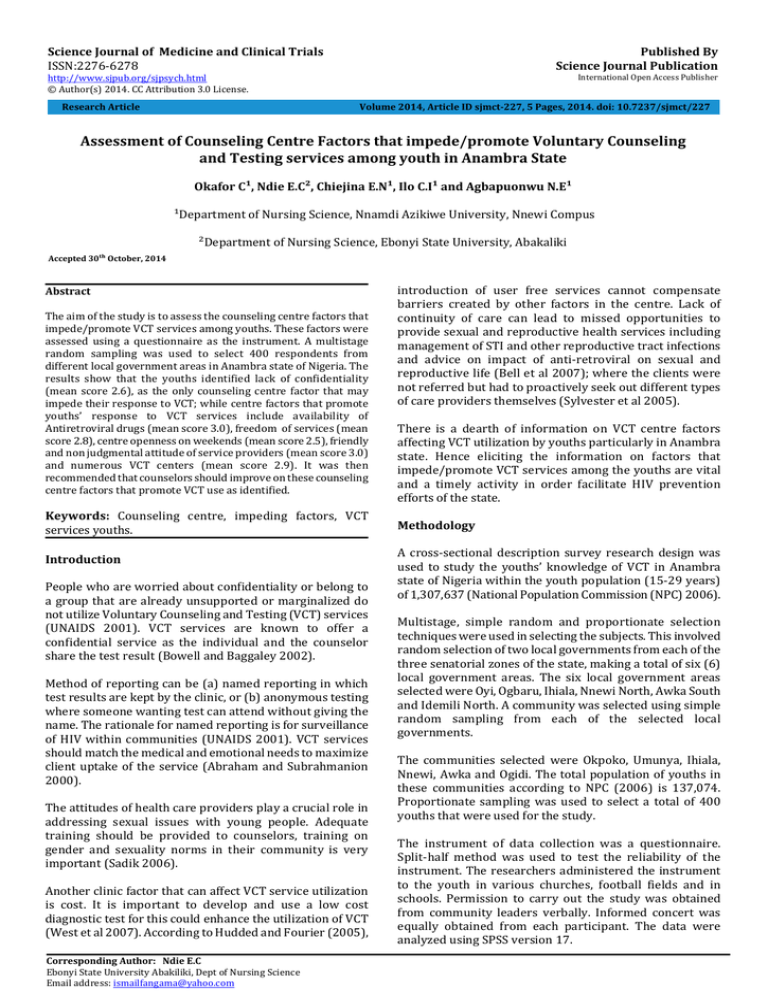
Published By Science Journal Publication Science Journal of Medicine and Clinical Trials ISSN:2276-6278 International Open Access Publisher http://www.sjpub.org/sjpsych.html © Author(s) 2014. CC Attribution 3.0 License. Research Article Volume 2014, Article ID sjmct-227, 5 Pages, 2014. doi: 10.7237/sjmct/227 Assessment of Counseling Centre Factors that impede/promote Voluntary Counseling and Testing services among youth in Anambra State Okafor C¹, Ndie E.C², Chiejina E.N¹, Ilo C.I¹ and Agbapuonwu N.E¹ ¹Department of Nursing Science, Nnamdi Azikiwe University, Nnewi Compus ²Department of Nursing Science, Ebonyi State University, Abakaliki Accepted 30�� October, 2014 Abstract The aim of the study is to assess the counseling centre factors that impede/promote VCT services among youths. These factors were assessed using a questionnaire as the instrument. A multistage random sampling was used to select 400 respondents from different local government areas in Anambra state of Nigeria. The results show that the youths identified lack of confidentiality (mean score 2.6), as the only counseling centre factor that may impede their response to VCT; while centre factors that promote youths’ response to VCT services include availability of Antiretroviral drugs (mean score 3.0), freedom of services (mean score 2.8), centre openness on weekends (mean score 2.5), friendly and non judgmental attitude of service providers (mean score 3.0) and numerous VCT centers (mean score 2.9). It was then recommended that counselors should improve on these counseling centre factors that promote VCT use as identified. Keywords: Counseling centre, impeding factors, VCT services youths. Introduction People who are worried about confidentiality or belong to a group that are already unsupported or marginalized do not utilize Voluntary Counseling and Testing (VCT) services (UNAIDS 2001). VCT services are known to offer a confidential service as the individual and the counselor share the test result (Bowell and Baggaley 2002). Method of reporting can be (a) named reporting in which test results are kept by the clinic, or (b) anonymous testing where someone wanting test can attend without giving the name. The rationale for named reporting is for surveillance of HIV within communities (UNAIDS 2001). VCT services should match the medical and emotional needs to maximize client uptake of the service (Abraham and Subrahmanion 2000). The attitudes of health care providers play a crucial role in addressing sexual issues with young people. Adequate training should be provided to counselors, training on gender and sexuality norms in their community is very important (Sadik 2006). Another clinic factor that can affect VCT service utilization is cost. It is important to develop and use a low cost diagnostic test for this could enhance the utilization of VCT (West et al 2007). According to Hudded and Fourier (2005), Corresponding Author: Ndie E.C Ebonyi State University Abakiliki, Dept of Nursing Science Email address: ismailfangama@yahoo.com introduction of user free services cannot compensate barriers created by other factors in the centre. Lack of continuity of care can lead to missed opportunities to provide sexual and reproductive health services including management of STI and other reproductive tract infections and advice on impact of anti-retroviral on sexual and reproductive life (Bell et al 2007); where the clients were not referred but had to proactively seek out different types of care providers themselves (Sylvester et al 2005). There is a dearth of information on VCT centre factors affecting VCT utilization by youths particularly in Anambra state. Hence eliciting the information on factors that impede/promote VCT services among the youths are vital and a timely activity in order facilitate HIV prevention efforts of the state. Methodology A cross-sectional description survey research design was used to study the youths’ knowledge of VCT in Anambra state of Nigeria within the youth population (15-29 years) of 1,307,637 (National Population Commission (NPC) 2006). Multistage, simple random and proportionate selection techniques were used in selecting the subjects. This involved random selection of two local governments from each of the three senatorial zones of the state, making a total of six (6) local government areas. The six local government areas selected were Oyi, Ogbaru, Ihiala, Nnewi North, Awka South and Idemili North. A community was selected using simple random sampling from each of the selected local governments. The communities selected were Okpoko, Umunya, Ihiala, Nnewi, Awka and Ogidi. The total population of youths in these communities according to NPC (2006) is 137,074. Proportionate sampling was used to select a total of 400 youths that were used for the study. The instrument of data collection was a questionnaire. Split-half method was used to test the reliability of the instrument. The researchers administered the instrument to the youth in various churches, football fields and in schools. Permission to carry out the study was obtained from community leaders verbally. Informed concert was equally obtained from each participant. The data were analyzed using SPSS version 17. Science Journal of Medicine and Clinical Trial ( ISSN:2276-6278) page 2 RESULTS AND DISCUSSION Table 1: Counseling centre factors that impede/promote VCT N=397 Counseling centre factors that impede VCT SA A D SD X Cost of VCT 49 95 151 102 2.2 Lack of confidentiality 83 142 105 67 2.6 Judgmental attitude of service providers 90 113 132 62 2.4 Poor quality of VCT service 57 106 168 66 2.4 Inconvenient hours of service 57 117 148 75 2.4 Long waiting period for result 53 100 145 99 2.3 Distance of VCT centre 52 102 154 89 2.3 Lack of treatment with ARVD 63 93 150 91 2.3 63(16%) 109(27%) 144(36%) 81(21%) 2.4 Average % , Table 2: Counseling Centre factors that promote VCT Counseling centre factors that impede VCT Assurance of confidentiality of test Availability of treatment with ARVD Provision of condom Free services ICentre remaining open on weekends Friendly and non judgmental attitude of service providers Nearness of VCT centre Average % SA A D SD X 149 168 63 17 3.1 122 162 86 27 3.0 57 80 133 127 2.2 86 140 128 43 2.8 62 121 154 60 2.5 128 170 71 28 3.0 122 158 76 41 2.9 104(26%) 143(36%) 102(26%) 49(12%) 2.8 For provider and counseling centre factors that impede VCT as shown in Table 1 and 2, 49 respondents strongly agreed to cost of VCT as a factor that may impede or hinder VCT, respondents just agreed, 151 disagreed and 102 strongly disagreed to the item. Their responses yielded a mean score of 2.2 negative responses. Judgmental attitude of service providers received 83 strongly agreed responses., 142 agreed responses, while 105 and 67 respondents disagreed and strongly disagreed to the item respectively. A mean score of 2.6 positive responses was got. 57 and 106 respondents strongly agreed and agreed to poor quality of VCT services while 168 disagreed and 66 respondents strongly disagreed. A mean score of 2.4 was got. Inconvenient hours of service received 57 strongly disagreed responses. A mean score of 2.6 negative responses was got from their responses. For long waiting period for result, 53 respondents strongly agreed to the item, 100 respondents just agreed, while 145 disagreed and 99 strongly disagreed. Their responses yielded a mean score 2.3 negative responses. Distance of VCT centre and lack of treatment with ARVD had a mean score of 2.3 negative responses, respectively. For counseling center factors that promote VCT, assurance of confidentiality of test received 149 strongly agreed responses, 168 agreed How to Cite this Article: Okafor C, Ndie E.C, Chiejina E.N, Ilo C.I and Agbapuonwu N.E, "Assessment of Counseling Centre Factors that impede/promote Voluntary Counseling and Testing services among youth in Anambra State", Science Journal of Medicine and Clinical Trials, Volume 2014, Article ID sjmct-227, 5 Pages, 2014. doi: 10.7237/sjmct/227 page 3 Science Journal of Medicine and Clinical Trial ( ISSN:2276-6278) responses; 63 disagreed and 17 strongly disagreed responses. Responses yielded a mean score of 3.1 positive responses. counseling centre factors that impede VCT. On the other hand, an average of 144(35%) youths disagreed and 81(21%) strongly disagreed giving a total of 225(57%) responses representing negative response to counseling center factors that impede VCT. Availability of treatment with ARVD had a mean score of 3.0 with 122 respondents strongly agreeing and 162 agreeing to the item. 86 and 27 respondents disagreed and strongly disagreed respectively. Provision of condom had a mean score of 2.2. Free services of VCT had a mean score of 2.8 positive responses with 86 respondents strongly agreeing to the item, 128 respondents disagreed and 43 strongly disagreed. A mean score of 2.5 was got from responses to center being open on weekends. For friendly and non judgmental attitude of service provider, a mean score of 3.0 was got from the responses with 12 strongly agreeing to the item, 170 agreeing, 71 showing disagreement and 28 strongly disagreeing. For counseling center factors that promote VCT, youths had average of 104(26%) for strongly agreed and 143(36%) for agreed, making a total of 247(26%) responses representing positive response while they had an average of 102(26%) disagreed response and 49(12%) strongly disagreed responses making a total of 151(38%) responses representing negative response to counseling center factors that hinder VCT. Kruskal Wallis and Mann Whitney statistics were used to examine the association between some demographic variables like age, sex, educational level, marital status and occupation; and factors that either impede or promote utilization of VCT. Using Mann Whitney test statistics, gender showed no significant relationship with factors that either promote or hinder VCT (P>0.05) for factors that promote VCT and (P>0.05) level of significance for factors that hinder VCT. For nearness of VCT center as a factor that promotes VCT, 122 respondents strongly agreed to the item, 158 agreed while 76 disagreed and 41 strongly disagreed. A mean score of 2.9 positive responses was got. The table equally shows that youths had average of 63(16%) responses for strongly agreed 109(27%) responses for agreed giving a total of 172(42%) responses representing positive response to Table 3: Association between demographic variables and factors that promote VCT using Kruskal Wallis test statistics Demographic variables Age Marital status Educational level Occupation Freq. (N=380) 15-19yrs 20-24yrs 25-29yrs Single Married Separated Divorced Widowed Primary Secondary Tertiary Apprentice Trading Private/company worker Govt. worker Applicant Student 126 151 103 334 24 11 7 4 8 184 188 14 28 24 N=380 Kruskal Wallis P-value 22.67 .000* 2.915 0.572 .000* 41.452 6.839 0.233 25 14 275 *Significant P<0.05 Table 3 shows that there is significant relationship between age (P=0.000)* and educational status (P=0.000)* of respondents and factors that promote VCT. Participants between 20-24years with higher educational level agreed to the factors that promote VCT. Table 4 reveals that there is significant relationship between marital status and educational level of respondents and factors that hinder VCT. Never married youths with higher educational level agreed to the factors that hinder VCT among youths in Anambra state. Pearson R Spearman correlation was further used to correlate demographic variables with factors that either promote or hinder VCT. The findings reveal that age (PearsonR =.203. P=.000, P<0.05 level of significance) and educational level (PearsonR =.321, P<0.05 level of significance) of respondents correlated with factors that promote VCT. Only educational level (PearsonR=-.136, P= .008, P<0.05 level of significance) of respondents correlated with factors that hinder VCT. Hence interventions that improve factors that promote VCT should focus more on youths who are less educated and younger. How to Cite this Article: Okafor C, Ndie E.C, Chiejina E.N, Ilo C.I and Agbapuonwu N.E, "Assessment of Counseling Centre Factors that impede/promote Voluntary Counseling and Testing services among youth in Anambra State", Science Journal of Medicine and Clinical Trials, Volume 2014, Article ID sjmct-227, 5 Pages, 2014. doi: 10.7237/sjmct/227 Science Journal of Medicine and Clinical Trial ( ISSN:2276-6278) page 4 Table 3: Association between demographic variables and factors that hinder VCT N=380 Demographic variables Age Marital status Educational level Occupation Freq. (N=380) 15-19yrs 20-24yrs 25-29yrs Single Married Separated Divorced Widowed Primary Secondary Tertiary Apprentice Trading Private/company worker Govt. worker Applicant Student Kruskal Wallis P-value 22.67 0.182 22.671 .000* 126 151 103 334 24 11 7 4 8 184 188 14 28 24 .015* 8.437 1.752 0.882 25 14 275 Significant P<0.05 Counseling centre factors that impede/promote youths' response to VCT Youths identified lack of confidentiality (mean 2.6) as the only counseling centre factors that may impede their response to VCT. Issues on confidentiality were found in many studies and literatures to affect VCT use. A research in Kenya and Uganda by Horizon (2001) revealed that many young people wished that confidentiality will be ensured in matters concerning HIV counseling and testing. International HIV/AIDS Alliance in 2006 reported that many people would prefer a setting for HIV counseling where counselors understand the consequences of violating confidentiality. On counseling centre factors that promote youths' response to VCT, the following were identified. ● Availability of treatment with Antiretroviral drugs (mean score 3.0). International HIV Treatment Preparedness Summit in 2003 saw provision of treatment with ARVD as something that would encourage people to learn facts about HIV and utilize counseling, testing and care; hence the findings in this study are in line with their postulation. ● Free services (mean score 2.8). This finding agrees with studies in Kenya, Zambia, Zimbabwe and United States which suggest that cost factors significantly affect uptake and acceptability of VCT services (Danesyn et al 2002). " Center remaining open on weekends (mean score 2.5). This finding also agrees with postulations of Boswell and Baggaley (2002) that uptake of youths in this study equally identified availability of support services and lack of stigma/discrimination as factors that will promote their response to VCT. This seems to be in line with the observation of Feldman (200) that there is less stigma associated with HIV in communities that have good counseling services, and active support group services. VCT is significantly influenced by service operating hours and that approaches known to be effective with young people include offering services in weekends as well as center remaining open through lunch or break hours. ● Friendly and non judgmental attitudes of service providers (mean score 3.0). This finding is not different from the findings of Mcphail et al in 2008 among South African Youths which revealed that young people want counselors who are friendly and will not shout at them. It also agrees with the postulations of Boswell and Baggaley (2002) that young people want counselors or medical personnel who would not judge them as being sexually active and having difficulty engaging and listening to their needs. ● Nearness of VCT centre (mean score 2.9). This concurs with the finding of Onabanjo in 2004 in Lagos, Nigeria where 75% of the students used for his study identified lack of VCT centre in and around the school as a deterrent to their using CVT services. Finally, assurance that test result will be confidential (mean score 3.1) was identified by youths as a counseling center factor that will promote VCT and this has been previously discussed. Conclusion It can be concluded from this study that counseling centre factor that may impede youths response to VCT service include lack of confidentiality while factors that promote it are availability of antiretroviral drugs, free services, centre openness on weekends and friendly and non judgmental attitude of the providers. Acknowledgments How to Cite this Article: Okafor C, Ndie E.C, Chiejina E.N, Ilo C.I and Agbapuonwu N.E, "Assessment of Counseling Centre Factors that impede/promote Voluntary Counseling and Testing services among youth in Anambra State", Science Journal of Medicine and Clinical Trials, Volume 2014, Article ID sjmct-227, 5 Pages, 2014. doi: 10.7237/sjmct/227 page 5 Recommendations It is recommended that counselor must maintain confidentiality, have antiretroviral drugs, provide free services and maintain a friendly and non-judgmental attitude. Science Journal of Medicine and Clinical Trial( ISSN:2276-6278) 7. West, G.R., Corneli, A.L, Best K, Kirjion K.M and Cates W (2000) focusing HIV prevention on those most likely to transmit the virus. AIDS Education and prevention 19(4) 275-278. 8. Hadded S and Fourier P (20050 quality, cost and utilization of health services, in developing countries: a longitudinal study in Zaire. Soc. Sci. Med. 40: 743-745. 9. Sylvester, L; Raven J and Price J (2005); Analysis of the gender dimension in the scale up of anti retroviral therapy and the extent to which free treatment at point of delivery ensures equitable access for women. Liverpool Gender and Health group. School of Tropical medicine. References 1. Abraham I and Subrahmonion C (2000); Barriers towards the implementation/utilization of HIV counseling services. Paper presented at the 12th Switeralnd, Abstract 24339 2. Boswell D. and Baggely R (2002) voluntary counseling and testing: A reference guide, Responding to the Need of young people, children pregnant women and their partners, Arlington, VA: family Health International. 3. Bell E., Mthemba P., O' Sullivan, S (2007) ;Sexual and reproductive health services and HIV Testing: perspective and experiences of women and men living with HIV/AIDS. Reproductive health matters 15: 113-135 4. UNAIDS (2001) The Impact of Voluntary Counseling and Testing: A Global review of the benefits and challenges 5. UNAIDS/01/32E available ofat: http://www.unaids.org.(Acce ssed: 6/3/2010) 6. Sadik N (2006); Male sexual health in Asia and the pacific. International consultation on risk and responsibility. New Delhi. Available at: http:/dota.unaids.org/pub/speech/2006/ 200609235prinsfiddsdikemptdfN. (Acce ssed: 13/9/2009) 10. Horizon (2001); HIV voluntary counseling and testing among youth ages 14-21: Results from an explanatory study in Nairobi, Kenya, Kampala and Musaka, Uganda. Horizon final report Washington DC. 11. Mcphail CL Pittifor, A Coastes, T and Ree, H (2000); "You must do the test to know your status" Attitudes to HIV voluntary counseling and testing for adolescent among South African youth and parents. Journal of Health Edcuation Behaviour 35: 85-100. 12. Onabanjo O (2004); Voluntary counseling and testing (VCT) unwilling attitude of youth in the tertiary institution in Lagos. Nig. Int. AIDS 15(1): 11-16 How to Cite this Article: Okafor C, Ndie E.C, Chiejina E.N, Ilo C.I and Agbapuonwu N.E, "Assessment of Counseling Centre Factors that impede/promote Voluntary Counseling and Testing services among youth in Anambra State", Science Journal of Medicine and Clinical Trials, Volume 2014, Article ID sjmct-227, 5 Pages, 2014. doi: 10.7237/sjmct/227
